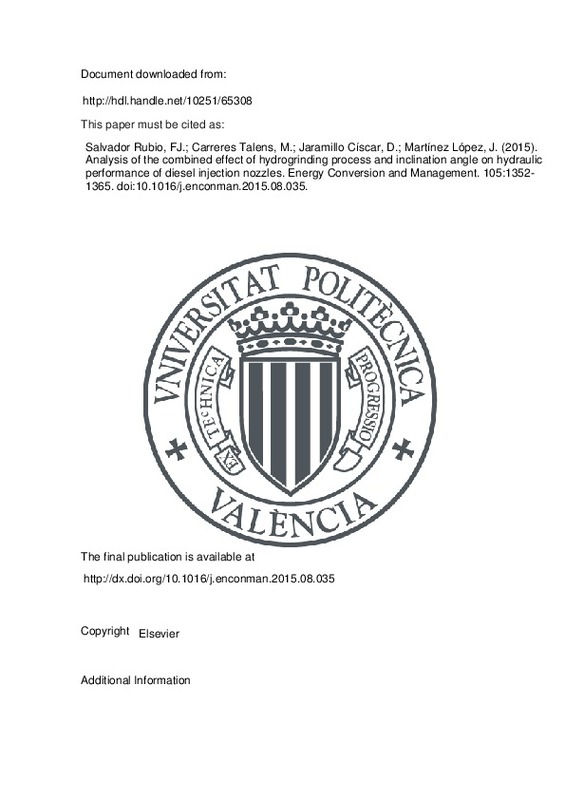JavaScript is disabled for your browser. Some features of this site may not work without it.
Buscar en RiuNet
Listar
Mi cuenta
Estadísticas
Ayuda RiuNet
Admin. UPV
Analysis of the combined effect of hydrogrinding process and inclination angle on hydraulic performance of diesel injection nozzles
Mostrar el registro sencillo del ítem
Ficheros en el ítem
| dc.contributor.author | Salvador Rubio, Francisco Javier
|
es_ES |
| dc.contributor.author | Carreres Talens, Marcos
|
es_ES |
| dc.contributor.author | Jaramillo Císcar, David
|
es_ES |
| dc.contributor.author | Martínez López, Jorge
|
es_ES |
| dc.date.accessioned | 2016-06-06T11:44:37Z | |
| dc.date.available | 2016-06-06T11:44:37Z | |
| dc.date.issued | 2015-11-15 | |
| dc.identifier.issn | 0196-8904 | |
| dc.identifier.uri | http://hdl.handle.net/10251/65308 | |
| dc.description.abstract | A computational study to investigate the influence of the orifices inclination and the rounding radius at the orifice inlet (consequence of the hydro-erosive grinding process applied after the orifices machining) over the internal nozzle flow is performed in this paper. The study starts with the analysis of experimental results where the mass flow and momentum flux of two nozzles with very different values of these two variables are compared. This analysis shows relatively small differences in terms of mass flow and momentum flux, since the higher losses associated to the higher deflection of the streamlines with a higher inclination of the orifices are counteracted by the higher rounding radius, which favors the flow entrance to the orifice. To explain this experimental outcome, an extensive computational study involving nine geometries that combine different inclination angles and rounding radius is conducted, in order to quantify the influence of both parameters on the flow separately, as well as to assess the potential of their combination. These geometries are compared in terms of discharge coefficient, critical cavitation conditions and effective injection velocity, among others. Results show differences up to 15% in terms of mass flow rate and 8% for the effective injection velocity among the two extreme cases (lowest inclination and highest hydro-erosion level versus the nozzle with the highest inclination and lowest hydro-erosion level). Given the importance of these phenomena on the subsequent mixing and combustion processes, the results hereby presented are of interest for Diesel engines injectors and combustion chambers designers. | es_ES |
| dc.description.sponsorship | This work was partly sponsored by "Ministerio de Economia y Competitividad" in the frame of the project "Comprension de la influencia de combustibles no convencionales en el proceso de inyeccion y combustion tipo diesel", Reference TRA2012-36932. The equipment used in this work has been partially supported by FEDER project funds "Dotacion de infraestructuras cientifico tecnicas para el Centro Integral de Mejora Energetica y Medioambiental de Sistemas de Transporte (CiMeT), (FEDER-ICTS-2012-06)", in the frame of the operation program of unique scientific and technical infrastructure of the Ministry of Science and Innovation of Spain. This support is gratefully acknowledged by the authors. | en_EN |
| dc.language | Inglés | es_ES |
| dc.publisher | Elsevier | es_ES |
| dc.relation.ispartof | Energy Conversion and Management | es_ES |
| dc.rights | Reserva de todos los derechos | es_ES |
| dc.subject | Diesel | es_ES |
| dc.subject | Injection | es_ES |
| dc.subject | Nozzle | es_ES |
| dc.subject | Inclination | es_ES |
| dc.subject | Hydrogrinding | es_ES |
| dc.subject | Cavitation | es_ES |
| dc.subject.classification | INGENIERIA AEROESPACIAL | es_ES |
| dc.subject.classification | MAQUINAS Y MOTORES TERMICOS | es_ES |
| dc.title | Analysis of the combined effect of hydrogrinding process and inclination angle on hydraulic performance of diesel injection nozzles | es_ES |
| dc.type | Artículo | es_ES |
| dc.identifier.doi | 10.1016/j.enconman.2015.08.035 | |
| dc.relation.projectID | info:eu-repo/grantAgreement/MINECO//TRA2012-36932/ES/COMPRENSION DE LA INFLUENCIA DE COMBUSTIBLES NO CONVENCIONALES EN EL PROCESO DE INYECCION Y COMBUSTION TIPO DIESEL/ | |
| dc.relation.projectID | info:eu-repo/grantAgreement/MINECO//ICTS-2012-06/ES/Dotación de infraestructuras científico técnicas para el Centro Integral de Mejora Energética y Medioambiental de Sistemas de Transporte (CiMeT)/ | es_ES |
| dc.rights.accessRights | Abierto | es_ES |
| dc.contributor.affiliation | Universitat Politècnica de València. Departamento de Máquinas y Motores Térmicos - Departament de Màquines i Motors Tèrmics | es_ES |
| dc.contributor.affiliation | Universitat Politècnica de València. Instituto Universitario CMT-Motores Térmicos - Institut Universitari CMT-Motors Tèrmics | es_ES |
| dc.description.bibliographicCitation | Salvador Rubio, FJ.; Carreres Talens, M.; Jaramillo Císcar, D.; Martínez López, J. (2015). Analysis of the combined effect of hydrogrinding process and inclination angle on hydraulic performance of diesel injection nozzles. Energy Conversion and Management. 105:1352-1365. https://doi.org/10.1016/j.enconman.2015.08.035 | es_ES |
| dc.description.accrualMethod | S | es_ES |
| dc.relation.publisherversion | http://dx.doi.org/10.1016/j.enconman.2015.08.035 | es_ES |
| dc.description.upvformatpinicio | 1352 | es_ES |
| dc.description.upvformatpfin | 1365 | es_ES |
| dc.type.version | info:eu-repo/semantics/publishedVersion | es_ES |
| dc.description.volume | 105 | es_ES |
| dc.relation.senia | 293189 | es_ES |
| dc.contributor.funder | Ministerio de Economía y Competitividad | |
| dc.contributor.funder | European Regional Development Fund |







![[Cerrado]](/themes/UPV/images/candado.png)

